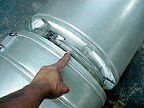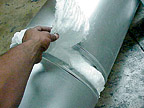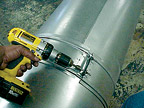
Factory-built grease ducts have been around for about 20 years, dovetailing with the general trend in construction toward prefabricated, modular components. Over the years, factory-built grease ducts have gained a small but growing share of the market, because of their modularity and the elimination of on-site welding. Use of these manufactured grease ducts has lagged over the years because of the higher direct cost and the additional requirement of a ventilated, fire-rated enclosure, or chase.
The newest generation of manufactured grease ducts, however, features better insulation, permitting zero clearance to combustibles, and eliminates the need for a fire-rated enclosure. This makes the cost/benefit analysis much more competitive and presents building owners with a better alternative to conventional welded grease ducts.
Commercial Kitchen Fires remain a Problem
Despite some positive trends and decreases in some regions, commercial kitchen fires continue to cause about $100 million annually in property damage, with cooking and heating activities being the primary culprits.There were 7,100 restaurant fires in 2002, the latest year available, according to the National Fire Data Center of the U.S. Fire Administration. These fires resulted in 108 injuries and $116 million in property loss. Add to that: lost revenue, lost productivity, cost of emergency services, and the disruption of lives and businesses. Cooking oil and grease were the materials that were most frequently first ignited, the report said.

Welded vs. Factory-Built Ducts
Typically, conventional grease ducts are made of carbon steel, fabricated, and welded into a rectangular shape. The conventional grease duct usually requires an 18-in. clearance separating the grease duct from combustible materials. In many cases, it also requires either a ventilated, fire-rated enclosure or a fire-rated insulation wrap system placed around it.This conventional solution may be less than optimal for several reasons. If the duct is to be protected with a separate, ventilated, fire-rated enclosure, the required clearance for the ventilated shaft consumes valuable space and does not lend itself to architectural designs that intentionally leave infrastructure exposed for aesthetic reasons.
The need for a skilled trades worker adds to labor costs. If the duct is to be wrapped with a fire-resistant insulation wrap system, a different subcontractor is required for the insulation wrap. Poor welds may not be obvious. Also, poor welds in an insulation wrap duct system might allow grease and/or duct cleaning liquid to leak into the insulation, deteriorating the insulation and accumulating grease into it, which is generally undetectable. In a fire, the wrapped insulation will cause heat to build up inside the duct. The duct could collapse and have to be completely replaced.
The rectangular shape of the conventional grease duct can itself create an increased fire hazard, because grease accumulates in the corners, despite attempts to clean the duct. Grease also can "hide" in the pores of carbon steel.
Manufacturers See an Opportunity
Seeing an opportunity to create a better mousetrap, duct manufacturers have attacked the problem and devised a solution that presents a better competitive alternative to conventional welded grease ducts. The manufacturers - including Selkirk's Metalbestos division, (www.selkirkinc.com); Metal-Fab (www.mtlfab.com), and Hart & Cooley/AMPCO, (www.americanmetalproducts.com) - have developed what they tout as a safer and cost-competitive solution for exhausting dangerous grease-laden vapors. These new designs conform to NFPA 96, Standard on Ventilation Control and Fire Protection of Commercial Cooking Operations, the nationally recognized standard on fire safety in commercial kitchens.Gone is the rectangular shape. The new pre-fab shape is cylindrical. Gone is welded carbon steel. It has been replaced by stainless steel. The new pre-fab ducts incorporate high-density insulation between an inner layer of stainless steel, and an outer layer of aluminized or stainless steel, creating a smooth duct wall that is several inches thick.
Instead of welds, the modular ducts connect together by means of simple, air-tight coupling systems that do not require the skills of an experienced tradesman. The factory-built ducts incorporate expansion joints, whereas the conventional welded grease ducts do not. As listed factory-built systems, the ducts do not require detailed on-site inspections to ensure their integrity. Some of the new factory-built duct systems have the additional advantage of meeting the UL Standard 2221, Tests of Fire Resistive Grease Duct Enclosure Assemblies to qualify as a zero-clearance grease duct with the fire resistance rating. In other words, the fire-rated enclosure is integrated and no exterior enclosure is necessary.
To qualify for the zero-clearance requirement, manufacturers have to subject their factory-built grease ducts to a 2,000 °F test for 30 min. The stainless steel gets red-hot but retains its shape without structural damage. The installation of factory-built grease ducts is very similar to the installation of factory-built boiler pressure stack and flue pipe. Also, supports and guiding for the factory-built ducts can be spaced farther apart compared to the conventional grease ducts. The inner duct and joints are the structural load bearing members of the assembly.
Cylindrical factory-built duct systems also offer improved airflow performance, since there is less flow resistance. They can also prove easy to clean, thanks in large part to eliminating the opportunity for grease to accumulate in the corners. They can be cleaned effectively with a "spin-jet" attachment on a pressure washer. Some of the factory built duct systems can incorporate automatic duct cleaning with spray nozzles. The stainless steel inner duct material is much less porous than carbon steel, which may also allow for more efficient cleaning.

New Design Options
For architects and designers, the cylindrical, zero clearance grease ducts create new possibilities and opportunities. The cylindrical shape is inherently more visually appealing, and the zero clearance means there is more free space to work with. The factory-built systems (currently listed in 5 in. to 36 in. ID sizes) can also work as architectural design elements, if desired.From the standpoint of cost, the new factory-built grease ducts are competitive with conventional welded ducts when all the costs are factored in. Stainless steel is about twice the cost of carbon steel, but factory-built ducts eliminate the need for skilled trades workers (welders), insulation contractors, and time-consuming inspections. In a commercial kitchen fire in which a conventional insulated carbon steel duct system is involved, the insulation may need to be removed and replaced when it is damaged, and if the fire is severe, the duct may also need to be replaced.
Finally, as the track record of factory-built grease ducts grows with respect to their performance, and as experience validates the replacement cost savings, building owners could also be in a stronger position to demand lower premiums from insurance companies. ES

